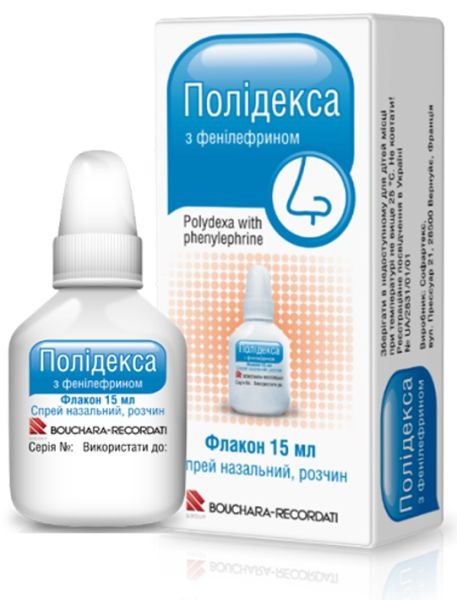

POLIDEKSA Z FENILEFRINOM

Ask a doctor about a prescription for POLIDEKSA Z FENILEFRINOM

How to use POLIDEKSA Z FENILEFRINOM
INSTRUCTIONS for medical use of the medicinal product DICLOFENAC-ZDOROVYE
Composition
The active substance: diclofenac; 1 g of gel contains 10 mg of sodium diclofenac; excipients: carbomer, concentrated ammonia solution, propylene glycol, glycerin, 96% ethanol, methylparaben (E 218), purified water.
Pharmaceutical form
Gel.
Main physical and chemical properties
A white gel of uniform consistency with a slight specific odor.
Pharmacotherapeutic group
Means for local application in case of joint and muscle pain. Non-steroidal anti-inflammatory drugs for topical use. Diclofenac. ATC code M02A A15.
Pharmacological properties
Pharmacodynamics
Diclofenac is a non-steroidal anti-inflammatory drug (NSAID) with pronounced anti-rheumatic, analgesic, anti-inflammatory, and antipyretic effects. The main mechanism of action is the inhibition of prostaglandin biosynthesis.
In inflammation caused by injuries or rheumatic diseases, the drug leads to a reduction in pain, swelling of tissues, and a reduction in the period of recovery of damaged joints, ligaments, tendons, and muscles. The drug reduces acute pain within 1 hour after initial application. Pain relief and functional disorders are achieved after 4 days of treatment with the drug. Due to its water-alcohol base, the drug also has a local anesthetic and cooling effect.
Pharmacokinetics
The amount of diclofenac absorbed through the skin is proportional to the area of its application and depends on both the total dose of the drug applied and the degree of skin hydration. After local application of 2.5 g of the drug to a skin surface area of 500 cm2, the degree of diclofenac absorption is approximately 6%. The use of an occlusive dressing for 10 hours leads to a threefold increase in diclofenac absorption.
After applying the drug to the skin of the joints of the hand and knee, diclofenac appears in the blood plasma (where its maximum concentration is approximately 100 times lower than after oral administration), in the synovial membrane, and in the synovial fluid. The binding of diclofenac to blood proteins is 99.7%.
Diclofenac accumulates in the skin, which serves as a reservoir from which the substance is gradually released into the surrounding tissues. From there, diclofenac mainly enters the deeper inflamed tissues, such as joints, where it continues to act and is determined in concentrations up to 20 times higher than in blood plasma.
Diclofenac is metabolized mainly by hydroxylation with the formation of several phenolic derivatives, two of which are pharmacologically active, but to a much lesser extent than diclofenac.
Diclofenac and its metabolites are excreted mainly in the urine. The total systemic plasma clearance of diclofenac is 263 ± 56 ml/min, and the terminal half-life is approximately 1-3 hours.
In case of renal or hepatic insufficiency, the metabolism and excretion of diclofenac from the body do not change.
Clinical characteristics
Indications
Local treatment of pain and inflammation of joints, muscles, ligaments, and tendons of rheumatic or traumatic origin.
Contraindications
Increased sensitivity to diclofenac or other components of the drug. History of attacks of bronchial asthma, urticaria, or acute rhinitis caused by taking acetylsalicylic acid or other NSAIDs; III trimester of pregnancy.
Interaction with other medicinal products and other types of interactions
Since the systemic absorption of diclofenac when applied topically is very low, the occurrence of interactions is unlikely.
Special warnings and precautions for use
The drug is recommended to be applied only to intact skin areas, avoiding contact with inflamed, wounded, or infected skin. Contact with the eyes and mucous membranes should be avoided. The drug should not be swallowed.
It should be used with caution with oral NSAIDs. The likelihood of developing systemic side effects when applying diclofenac topically is small compared to the use of its oral forms, but it is not excluded when applying the drug to relatively large areas of skin for a long time.
Treatment with the drug should be stopped if any skin rash appears.
The drug should not be applied under an airtight occlusive dressing, but its application under a non-occlusive dressing is allowed. In case of sprains, the affected area can be bandaged.
The drug contains propylene glycol, which can cause skin irritation.
Methylparaben (E 218), which is part of the medicinal product, can cause allergic reactions (possibly delayed).
Use during pregnancy or breastfeeding
Clinical data on the use of diclofenac during pregnancy are absent. Even if the systemic effect is lower compared to oral administration, it is unknown whether the systemic effect of diclofenac achieved after topical application can be harmful to the embryo/fetus. During the I and II trimesters of pregnancy, diclofenac should not be used without urgent need. If used, the dose should be as low as possible, and the duration of treatment should be as short as possible.
During the III trimester of pregnancy, systemic use of prostaglandin synthesis inhibitors, including diclofenac, can cause cardiopulmonary and renal toxicity in the fetus. In the late stages of pregnancy, prolonged bleeding may occur in both the mother and the child, as well as a delay in labor. Therefore, diclofenac is contraindicated during the last trimester of pregnancy (see "Contraindications" section).
In animals, no signs of harmful effects of the drug on pregnancy or embryonic development, childbirth, or postnatal development of the child have been found.
It is unknown whether diclofenac penetrates into breast milk when applied externally, so the use of the drug is not recommended during breastfeeding. However, if there are significant reasons for using the drug during breastfeeding, the drug should not be applied to the breast or large areas of skin and should not be used for a long time.
Data on the effect of diclofenac on human fertility when used externally are absent.
Ability to influence the reaction rate when driving vehicles or using other mechanisms
Does not affect.
Method of application and doses
Adults and children over 14 years old should apply 3-4 times a day, lightly rubbing into the skin. The amount of drug applied depends on the size of the affected area. Usually, 2-4 g, which corresponds to the size of a cherry or a walnut, is sufficient for application to an area of 400-800 cm2. After applying the drug, hands should be washed, except in cases where the area itself is being treated.
The duration of therapy depends on the nature of the disease and the effectiveness of treatment. The drug should not be used for more than 14 days in a row for injuries or rheumatism of soft tissues and for more than 21 days for joint pain of arthritic origin, unless otherwise recommended by a doctor.
It is necessary to consult a doctor if the symptoms of the disease do not decrease or worsen after 7 days of treatment.
Patient of elderly age do not require dose adjustment of the drug.
Children
The drug is not recommended for use in children under 14 years old. When using the drug in children over 14 years old for more than 7 days or if the symptoms of the disease worsen, it is necessary to consult a doctor.
Overdose
Overdose is unlikely due to the low absorption of diclofenac into the systemic bloodstream when applied topically. In case of accidental ingestion, the possibility of developing systemic side effects should be taken into account.
In case of accidental ingestion of the drug, the stomach should be immediately emptied, and an adsorbent should be taken. Symptomatic treatment with therapeutic measures for the treatment of NSAID poisoning should be applied.
Side effects
The drug is usually well tolerated. Undesirable reactions include mild temporary reactions on the skin at the site of application. In rare cases, allergic reactions may occur.
- Infections and invasions: pustular rashes.
- From the immune system: hypersensitivity reactions, angioedema.
- From the respiratory system: bronchial asthma.
- From the skin and subcutaneous tissue: rashes, urticaria, eczema, erythema, dermatitis (including contact, bullous), photosensitivity reactions, burning sensation of the skin, itching.
Shelf life
3 years.
Storage conditions
Store in the original packaging at a temperature not exceeding 25 °C. Store in a place inaccessible to children.
Packaging
30 g or 50 g in a tube in a box.
Release category
Without a prescription.
Manufacturer
Limited Liability Company "Pharmaceutical Company "Zdorovye"."
Location of the manufacturer and the address of the place of its activity
Ukraine, 61013, Kharkiv region, Kharkiv city, Shevchenko street, 22.
- Country of registration
- Active substance
- Prescription requiredYes
- Manufacturer
- This information is for reference only and does not constitute medical advice. Always consult a licensed doctor before taking any medication. Oladoctor is not responsible for medical decisions based on this content.
- Alternatives to POLIDEKSA Z FENILEFRINOMDosage form: spray, 27.5 mcg/doseActive substance: fluticasone furoateManufacturer: Глаксо Оперейшнс ЮК ЛімітедPrescription requiredDosage form: spray, 50 mcg/doseActive substance: mometasoneManufacturer: ФармеаPrescription requiredDosage form: spray, 50 mcg/doseActive substance: beclometasonePrescription not required
Alternatives to POLIDEKSA Z FENILEFRINOM in other countries
The best alternatives with the same active ingredient and therapeutic effect.
Alternative to POLIDEKSA Z FENILEFRINOM in Іспанія
Online doctors for POLIDEKSA Z FENILEFRINOM
Discuss dosage, side effects, interactions, contraindications, and prescription renewal for POLIDEKSA Z FENILEFRINOM – subject to medical assessment and local rules.







